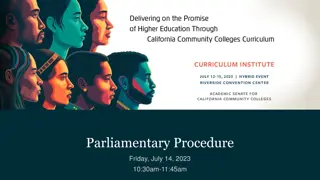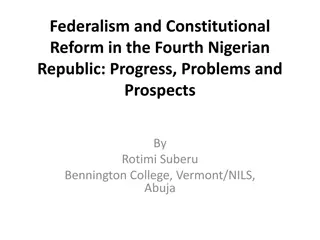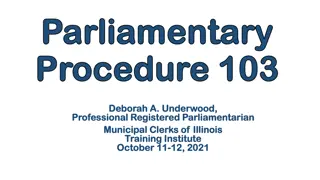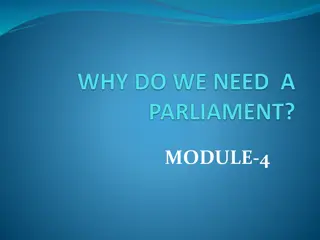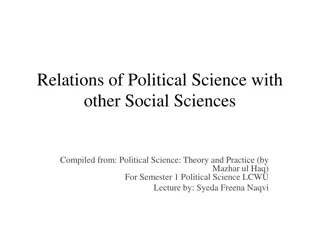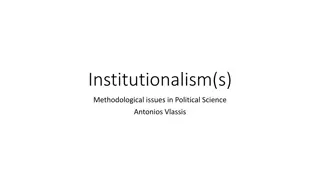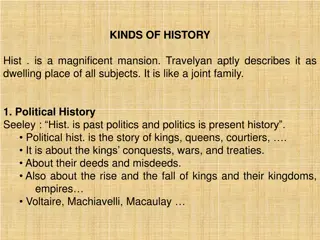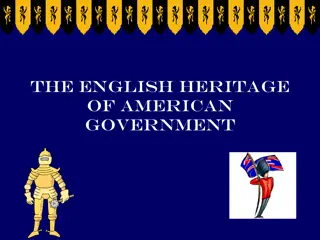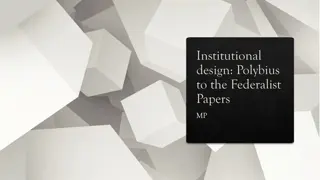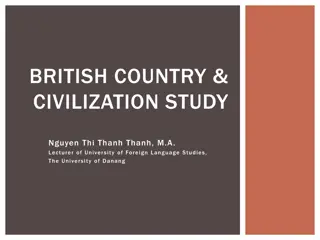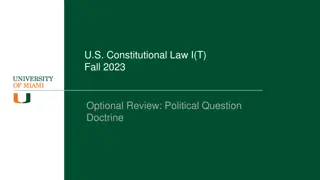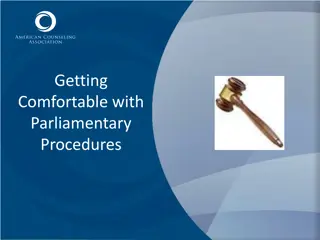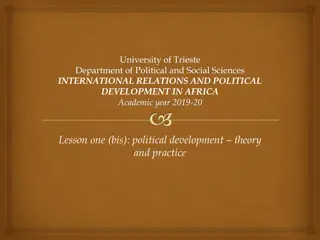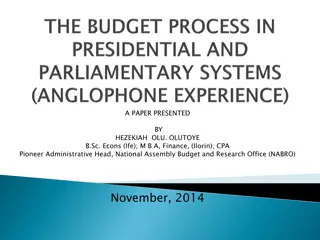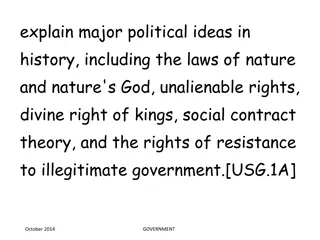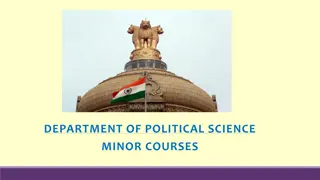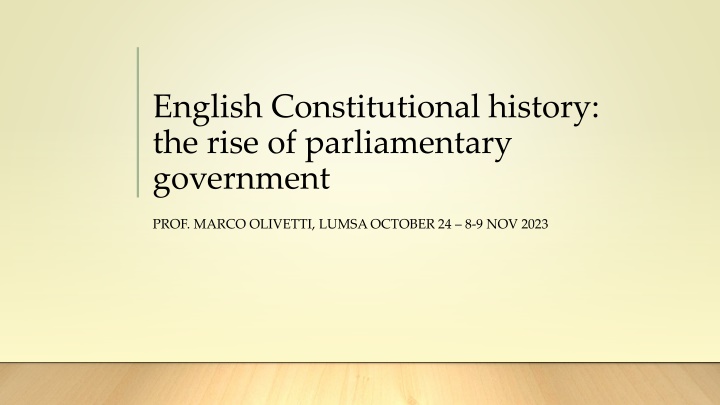
Rise of Parliamentary Government in English Constitutional History
Explore the transition period between 1780 and 1832, the role of the King, the great electoral reform of 1832, and the effects it had on the system of government in England. Discover how the electoral reform reshaped the composition of ministries, enhanced Cabinet independence, and solidified the influence of the electorate over the Crown, Lords, and Commons.
Download Presentation

Please find below an Image/Link to download the presentation.
The content on the website is provided AS IS for your information and personal use only. It may not be sold, licensed, or shared on other websites without obtaining consent from the author. If you encounter any issues during the download, it is possible that the publisher has removed the file from their server.
You are allowed to download the files provided on this website for personal or commercial use, subject to the condition that they are used lawfully. All files are the property of their respective owners.
The content on the website is provided AS IS for your information and personal use only. It may not be sold, licensed, or shared on other websites without obtaining consent from the author.
E N D
Presentation Transcript
English Constitutional history: the rise of parliamentary government PROF. MARCO OLIVETTI, LUMSAOCTOBER 24 8-9 NOV 2023
The practice and the theory of Parliamentary government THE TRANSITION PERIOD BETWEEN 1780 AND 1832-5 BUT ALSO The gradual reduction of the power of the King (madness of George III, regency 1810-20, weakness of George IV and William IV) Central role of the King on some fundamental issues (e.g. Catholic emancipation) Two strong/dominant Prime ministers (Pitt 1783-1801 & 1804-06; Liverpool 1812-27) King s initiative in the appointment (Cannings 1827) & in the dismissal (Melbourne 1834) of Prime ministers and Cabinets Trends towards solidarity in the Cabinet Decisive role of the King in the crisis before the Great reform of 1832 Cases of resignation of the Cabinet because of a defeat in the House of Commons
The great electoral reform of 1832 The ancient House of Commons and the crisis of its representative character The struggle for the reform 1830-32 The three cardinal points of the reform The representation of the people act, 1832 a) Disenfranchisement of the rotten boroughs b) Enfranchisement of new towns c) common 10 pounds franchise An evolution of the old electoral system and not a new one Limited representation, not universal adult suffrage The House of Commons becomes representative of the people, the electors increased from 400,000 to 650,000 (1 out of 6 adult males) The Government becomes expression not of royal confidence but of the confidence of the House (and specially of the parliamentary majority)
Effects of the electoral reform of 1832 By diminishing, if not wholly destroying, the system of patronage and nomination it deprived the Crown of the principal means it possessed of determining the composition of ministries and securing for them adequate parliamentary support, and enhanced the growing independence of the Cabinet and the supremacy of the Prime Minister. Though making no overwhelming addition to the electorate, it sufficiently changed the electoral system to ensure that the decision of larger and less easily manageable constituencies should determine which party obtained an effective majority in the Commons and therefore oblige the sovereign to accept that party s leaders as his ministers. Thereby it led directly to a thorough organization of parties in the constituencies and in Parliament. By ensuring the ultimate supremacy of the electorate, it vindicated that of the House of Commons over the Lords and destroyed the convention of a constitutional balance between Crown, Lords and Commons (D.L. Keir, Constitutional History of Modern Britain 1485-1937, IV ed., Black, London, 1950, p. 405)
The radical reform proposal: Cartism Universal suffrage No property qualifications Annual parliaments Equal representation Payment of MPs Vote by ballot
The climax of parliamentary government: 1832- 1867 EACH OF THE PARLIAMENTS ELECTED BETWEEN 1841 AND 1868 BROUGHT DOWN AT LEAST ONE GOVERNMENT GOVERNMENTS ARE MADE AND UNMADE IN THE HOUSE OF COMMONS 1841 Peel 1846 1835 Peel I resigns for lack of support in the newly elected HofC 1847 Russell 1852 1841 Melbourne II vote of want of confidence in the HofC 1852 Derby 1852, Aberdeen 1855 1846 Peel II HofC vote after the repeal of the Corn Laws 1857 Palmerston 1857 1852 Russell I HofC vote 1859 Derby 1859 1852 Derby I Budget defeat 1865 Russell 1866 1855 Aberdeen Defeat on the Crimean War 1858 Palmerston I an adverse vote on the Orsini crisis Parliament, not general election, is the central political arena 1859 Derby II defeat on a motion of confidence Many constituencies were uncontested in general elections 1865 Palmerston II Death 1866 Russell II Defeat on the parliamentary reform amendment
The theory of Parliamentary government Benjamin Constant (1814) and the monarch as a moderating power Benjamin Constant (1815) and ministerial responsibility Vitrolles and Guizot (with different accents) Chateaubriand ministers ought to be masters of the Chambers in fact, their servants in the form; Ministers when defeated in the Chambers have to resign unless they dissolve the elective Chamber Thiers 1829: The King reigns but does not govern
The early theory of Parliamentary government In Britain in the old theory of the Constitution continued to prevail until the mid XIX century (e.g. Cox, 1863) Early theories of parliamentary government: Charles J. Fox (and Whig party) approach in 1783 and later but they were advocating an evolution of the Constitution, not interpreting the real rules of the game of that time Earl of Grey 1858 The common description of the English Constitution as based on the separation of powers has ceased to be correct Walter Bagehot The English Constitution, 1867
From Blackstone to Bagehot Bagehot: the dignified and the efficient part of the English constitution The dignified part: the monarchy, the House of Lords The efficient part: the House of Commons, Cabinet, the Prime minister The Cabinet as a committee of the House of Commons: its most important Committee Parliamentary government as a system in which the Government (Cabinet) is composed by the leaders of the party who commands a majority in the House of commons Mainly ceremonial role of the Monarch and of the House of Lords
Bagehot chapter 1 There are two descriptions of the English Constitution which have exercised immense influence, but which are erroneous First, it is laid down as a principle of the English polity that in it the executive, the legislative and the judicial powers are quite divided that each is entrusted to a separate person or set of persons that no one of these can at all interfere with the work of the other Secondly, it is insisted that the peculiar excellence of the British constitution lies in a balanced union of the three powers No one can approach to an understanding of the English Constitution, or of others which, being the growth of many centuries, exercise a wide sway over mixed populations, unless he divide them into two classes. In such constitutions there are two parts (not indeed separable with microscopic accuracy ): first those which excite and preserve the reverence of the population the dignified parts ; and next, the efficient parts those by which it, in fact, works and rules.
Bagehot chapter 1 The efficient secret of the English Constitution may be described as the close union, the nearly complete fusion, of the executive and legislative powers. ( ) The connecting link is the Cabinet, By that new word we mean a committee of the legislative body selected to be the executive body. The legislature has many committees, but this is the greatest. It chooses for this, its main committee, the men in whom it has most confidence. It does not, it is true, choose them directly, but it is nearly omnipotent in choosing them indirectly. A century ago the Crown had a real choice of ministers, though it had no longer a choice of policy. ( ) As a rule, the nominal prime minister is chosen by the legislature, and the real prime minister for most purposes the leader of the House of commons almost without exception is so.
Bagehot chapter 1 The Queen is only at the head of the dignified part of the Constitution. The prime minister is at the head of the efficient part. The Cabinet is a board of control chosen by the legislature, out of persons whom it trusts and knows, to rule the nation . Naturally these are principally its own members The Cabinet, though a committee of the legislative assembly is a committee with a power which no assembly would have been persuaded to entrust to any committee. It is a committee which can dissolve the assembly which appointed it ( )
A periodization 1832-1867: the golden age of Parliamentary government: governments are formed in the House of Commons and fall in the House of Commons 1868: Disraeli resigns after the electoral defeat of the Conservative party without waiting to meet Parliament rise of the role of the electorate and of the Prime minister 1908-10: the conflict between the liberal majority in the House of Commons and the House of Lords Parliament act 1911 and the formal recognition of the prevalence of the House of Commons 1920s The changes in the party system: from one two-party system (Conservatives vs. Liberals) to another (Conservatives vs. Labour) Party discipline and party leadership and its impact on parliamentary government: Cabinet or prime-ministerial government
The monarchy in XIX and XX century Large formal powers, though unwritten (royal prerogative, based on custom and consisting in all the powers originally belonging to the monarchy and not limited by an act of Parliament): - Head of State and of Government, head of the Church - Power to prorogue and to dissolve Parliament - Power to expose in Parliament the program of the Cabinet (Speech from the Throne) - Power to withhold assent to legislation (exercised for the last time under Queen Ann) - Power to appoint members of the House of Lords, - War power, etc.
The monarchy in XIX and XX century The Conventions of the constitution require the King/Queen to exercise all his powers on the base of the advice of the Prime Minister (previously of the Cabinet) Conventions are unwritten and non legal rules that observed in a stable form by the political and constitutional actors (Dicey) At the close of Victoria s reign the Crown was weaker than in any other time in English history (L. Strachey, Queen Victoria, p. 301) The sovereign has, under a constitutional monarchy such as ours, three rights the right to be consulted, the right to encourage, the right to warn (Bagehot, 1867, p. 67) A formal Head of State, but a reserve of prestige and of legitimacy (the dignified part of the Constitution) and of informal suggestions Queen Victoria (1837-1901) as symbol of the XIX century Queen Elizabeth II (1952-2022) symbol of today s Britain
The House of Lords in the XIX century 200 members in 1760 (accession of George III), 423 in 1837 (accession of Queen Victoria), 592 in 1901 (death of Queen Victoria) During the XIX century, the aristocracy played a central role in politics: of 10 Prime ministers during Queen Victoria s reign (1837-1901), six were Peers, one was the son of a Duke, two belonged to the new aristocracy of commerce (Peel & Gladstone) and only one (Disraeli) belonged to the aristocracy neither of birth, nor wealth, nor education In the traditional constitution: equal position with the House of commons Predominance in the XVII century constitution through influence of the Lords in the selection of MPs Of the 10 Prime ministers, 5 were educated at Eton, three at Harrow and one at Westminster, while they attended the University either at Oxford (5) or at Cambridge (3) [Marriott, Modern England 1885-1945, p. 157] After 1832 predominance of the Commons; possible role of check and of counterweight of the House of Lords
The House of Lords in the XX century The clash between the two Chambers in 1909: the House of Lords rejected Lloyd George s budget Parliament Act 1911 and 1949: the bill adopted by the house of Commons shall become law without the consent of the House of Lords after a interval of time The Parliament Act 1911was approved under the threat by King George V of appointing enough new peers to change the majority in the House of Lords and only at the cost of two general elections of the House of Commons in 1910 The decline of the House of Lords: an honorary chamber Reforms after 1998 and further debate (specially on a territorial chamber, representing local governments or regions)
The House of Commons and the people Representation of the People Act, 1867 Enlargement of the franchise from 1 m. to 2 m. voters Ballot Act 1872 secrecy of the vote Representation of the People Act 1884 and Redistribution Act 1885 fusion of counties and boroughs, homogeneous franchise for cities and towns, rationalization of the distribution of seats, 40 per cent of adult males with right to vote ( 2 m. new electors, mostly urban artisans : Marriott), the one-member constituency as a general rule Representation of the People Act 1918 Adult male suffrage (and right to vote for women with more than 30 years of age) Representation of the People Act (Equal franchise) 1928 Universal suffrage with equality between men and women The electoral system remains the same: starting from 1884-5 it is the first-past-the-post, notwithstanding various reform proposals (in favor of Proportional Representation after 1918; for the AVS in the 2011 referendum) Currently the territory of the UK is divided in 650 one-member constituencies, in each of which party candidates compete The candidate who gets the highest number of votes in each constituency is elected
The House of Commons and the people Parliament Act 1911 reduced from 7 to 5 years the maximum duration of Parliaments The House of Commons may be dissolved before its normal term The Fixed Elections act 2011 regulated the power of dissolution, previously regarded as an expression of Royal prerogative The House of Commons may be dissolved only if: - The House approves a motion of censure against the Cabinet - The House adopts a motion for its own dissolution with a majority of two thirds of its members (2017, 2019) - The Dissolution and calling of Parliament act, 2022 has restored the prerogative power of dissolution of the House of Commons
Functions of Parliament (according to Bagehot, 1867) a) Elective function b) Expressive function c) Teaching function d) Informing function e) Legislative function f) Financial function
The Cabinet and the Prime minister The rise of Prime-ministerial power: from primus inter pares to head of government The relation of the Prime Minister with the electorate, with his party, with his cabinet colleagues, with the opposition in Parliament The base of the Prime minister s strength: a) The support of the electorate in the General election b) The support (confidence) of the majority of the House of commons c) The leadership of the party being in a majority of the House of commons d) The control of all the residual powers belonging to the monarch (royal prerogative), that, according to the conventions of the constitution, must be exercised following the advice of the Prime minister (e.g. prorogation of Parliament, dissolution of Parliament until 2011, etc.) this may be regarded as the tory element of the constitutional position of the Prime minister and of the Cabinet
The Cabinet and the Prime minister (While in the XIX century the Prime minister was frequently an aristocrat and often belonged to the House of Lords, in the XX and XXI century he must be a member of the House of Commons: see the preference for Baldwin instead of Lord Curzon in 1923 and the resignation from Lord Home from the Lords when appointed Premier in 1963) How to appoint a Prime Minister (after new elections and in other moments) The Prime Minister appoints the members of the Cabinet and may dismiss them How to remove a Prime Minister: a vote of the House of Commons; change of leadership in the governing party; a defeat in general elections The Prime minister is the chief of the party in Parliament, while the Cabinet is its Front Bench
The conventions of the Constitution We now have a whole system of political morality, a whole code of precepts for the guidance of public men, which will not be found in any page of either the statute or the common law, but which are in any page of either the statute or the common law, but are in practice held hardly less sacred than any principle embodied in the Great Charter or in the Petition of Rights (E. FREEMAN, The Growth of the English Constitution, 1872, p. 109). The conventions of the Constitution are customs, practices, maxims, or precepts which are not enforced or recognized by the Courts and make up a body not of laws, but of political ethics But a lawyer cannot master even the legal side of the English constitution without paying some attention to the nature of those constitutional understandings which necessarily engross the attention of historians or statesmen (A.V. DICEY, Introduction to the study of the law of the Constitution, VIII ed., Macmillan & co., London, 1915, p. 413.). These rules make up the constitutional morality of the day. They are all constantly acted upon, and, since they cannot be enforced by any Court of law, have no claim to be considered laws. They are multifarious (but) they are all, or at any rate most of them, rules for determining the mode in which the discretionary powers of the Crown (or of the Ministers as servants of the Crown) ought to be exercised (Dicey, p. 418). The conventions of the constitution are rules or customs determining the mode in which the discretionary power of the executive, or in technical language the prerogative, ought (i.e. is expected by the nation) to be employed (Dicey,p. 424).
Political Parties Defeat of the Whigs in 1783-4 and rise of William Pitt Pitt vs. Charles J. Fox new Tories ( pittites ) vs. Whigs? Lord Liverpool s long hegemony 1812-1827 (a new toryism?) and the Whig opposition The Whigs in power 1830-41 Robert Peel s Tarnworth Manifesto (1834), the Carlton Club and the birth of the new Conservative party Lichfield House compact of Feb. 1835 (Whigs, radicals & O Connell Irish MPs), the Reform Club and the origin of the Liberal Party Former peelites , Liberals and Whigs merge into the Liberal Party 1859 Organization of parties outside parliament, at the constituency level
Political Parties More or less regular alternation in power of Liberals and Conservatives between 1867 and 1922 (two-party system) Decline of the Liberal party in the 1920s and 1930s (three-party system) Rise of the Labour Party in the 1920s and after 1945 (return to a two party system) New parties: Alliance, then Liberal democratic party in the 1980s; UKIP (for Brexit); Scottish Nationalist Party (for Scottish independence) From parliamentary parties to organizations living in the Country and represented in Parliament (in particular the relations of the Labour Party with the Trade Unions) The party and its leader Selecting the leader: from a process governed by the parliamentary caucus to a process involving party members Parliamentary discipline The MP and his constituency
The evolution of parliamentary government in the second half of the XX century: the Westminster model The electoral system: first past the post (see slide nr. 19) On a national base, with national parties, this system gives a surplus of representation to the party who gets the larger number of votes and usually also to the second party at national level (Cons. and Labour) Third and other national parties are usually strongly penalized (Liberals after 1945), unless concentrated in a specific area This electoral system working at national level with a homogenous electorate tends to produce a two-party system Very frequently elections produce a Parliament with a one-party majority and give to the party, the government and the Prime minister a mandate Electors usually choose men and measures : a) They choose not only the MPs, but, de facto, through the MP and the party, they choose the Prime Minister and his team b) As elections are fought on party manifestos (the program of the party) the election also approves a party platform In the following election, the voters may verify if the men and measures they had chosen still correspond to their preferences (responsibility)
One-party governments as the rule and its exceptions A tradition of single-party majority governments The main parties (Conservatives and Labour) are disciplined and organized with clear and visible leaders The party who gets the majority of seats in general elections forms the new government The leader of the party with a majority in the House of Commons becomes Prime minister Formally a government may be unseated through a vote in Parliament, but this is unlikely A Prime Minister may be removed also removing him from the leadership of his party Even though a no-confidence vote is always possible in principle, actually a majority government may be unseated only through new general elections Minority governments (1923-24; 1929-31; 1950-51,1974, 2017-19) Coalitions only in wartime (1916-18 and 1940-45), in 1918-22, in 1929-35 and in 2010-15 (Cons.+Libs)
Concentration of powers and checks & balances? In the Westminster system, the political power is highly concentrated in a chain composed by the Prime Minister, his Cabinet, his parliamentary caucus and his Party Are there still any limitation to the concentration of powers? a) The judicial system and the common law b) The house of lords and the monarch: a check existing today only on the paper Criticism of the concentration of powers in the hands of the Prime Minister and of lack of checks and balances: The Elected Monarch (Benemy, 1965) c) The party as a device in the hands of the prime minister, but also as a check: the Thatcher case (1990) the removal of a once popular Prime Minister, who had become a liability, by decision of its own party d) Parliamentary procedure and public opinion e) 1973-2020: the European Union
Constitutional Reforms after 1998 The English/British/UK Constitution continues to evolve and is not frozen in time In a unwritten Constitution, constitutional reforms are adopted through ordinary parliamentary legislation Devolution for Scotland, Wales and Northern Ireland: regional parliaments and regional governments with legislative and administrative powers (only administrative in Wales) Human Rights Act 1998 the European Convention of Human Rights as a Charter of Rights for the United Kingdom House of Lords Act 1999: Life peers + 87 Hereditary members + Bishops A Supreme Court for the United Kingdom (2007) as highest court of the Kingdom Fixed Term Elections act 2011 a regulation of the power of dissolution of the House of Commons Derogation of that Act in 2022 The referendum on electoral reform in 2011: the people refused to abandon the first-past-the-post system and to substitute it with the (Australian) Alternative Vote System A procedure for the recall of MPs, in case of corruption The 2016 referendum and Brexit (2020)

